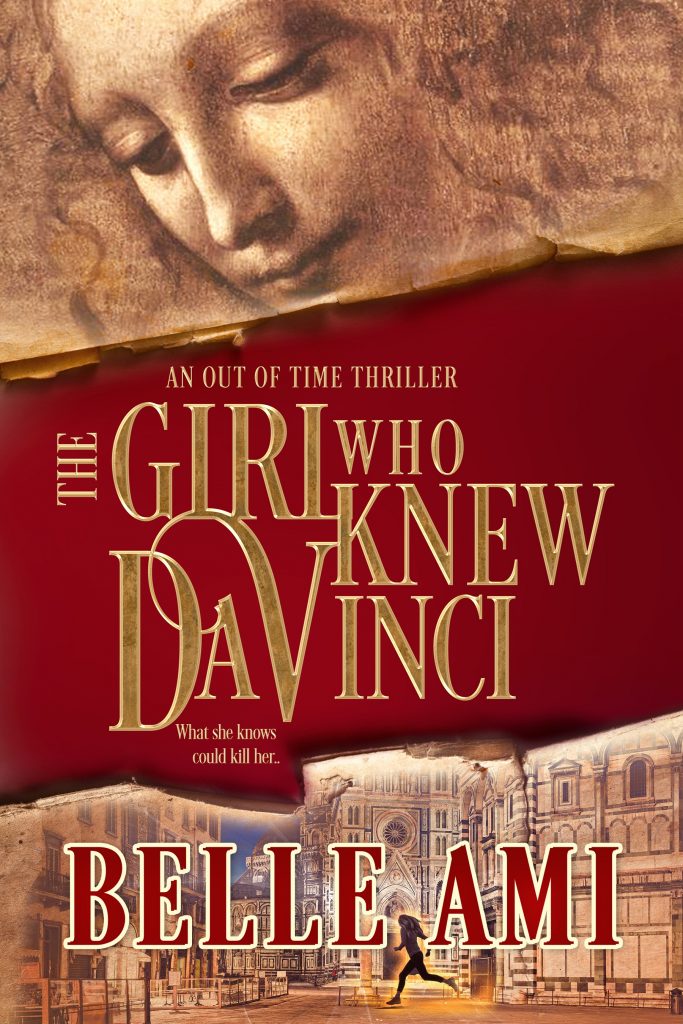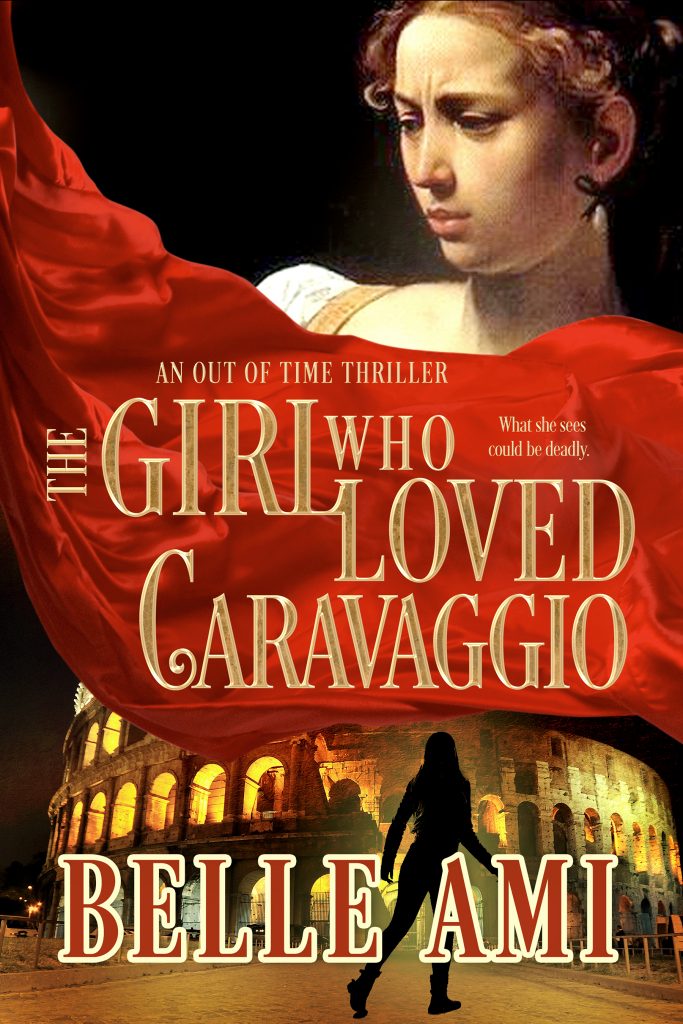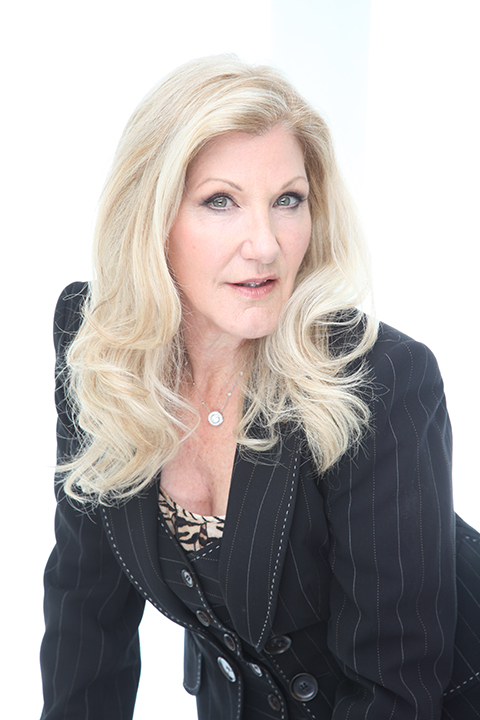



Interview with Belle Ami
by Kel Johnson
Belle is the 2019 RAVEN Award Winner for Mystery Suspense and a Readers Favorite Book Award Finalist for her Time Travel Romance THE GIRL WHO KNEW DA VINCI. (Book 1 Out of Time Series). The Girl Who Loved Caravaggio is the Grand Champion in Cover Design for Top Shelf Magazine and is the 2020 Winner of the Book Excellence Award.
Hello and welcome, Belle.
Hi Kel, we go well together, Kel & Belle.
Yes, we do. My first question for you is what drew you to write about time travel and the art world?
I attended Bryn Mawr College, and my major was art history with a minor in literature. Art has always been a passion for me.
When I was twenty-one, a long time ago, I had a vision for a screenplay. The Girl Who Knew Da Vinci is a direct descendant of that vision. Reincarnation and past lives have always philosophically interested me. The series grew naturally out of the first book’s success.
My art-historian heroine, Angela Renatus, and her fiancé art detective, Alex Caine, have loved each other through many past lives. Each time they tragically lost each other until the present. In their present incarnations, they recover stolen and lost art, but their adventures are so much more than just a thriller to find a painting. Angela and Alex are trying to find the truth about an artist’s life and correct the historical record. In the books I manipulate between the past, the present, and the future through dreams, time-travel, and psychic visions. Apparently, I do it very successfully because no reader has ever complained that they were lost in time.
Time travel is such an ideal vehicle to take the reader back to other periods like the Renaissance and the Baroque. Bringing the past to life is very rewarding but demands a lot of research, which I’m a stickler about. In the writing though, I’m careful to sprinkle in the art-history, and not overload the reader with too much detail.
Next, are there parts of writing that cause you trouble, such as scenes or dialogue?
My editor says my scene writing and dialogue in the past is stellar. However, she’s always complaining I need to simplify my dialogue in the present. I tend to formalize it a bit, and it’s better when I don’t get too preachy. Thank goodness she’s there to call me on it, and we usually work it all out by the end of editing.
What’s the one book that you keep reading over and over again?
To tell you the truth, I never read a book more than once. First of all, I’m a voracious reader, and there are too many books in the world I want to read and not enough hours in the day. My TBR shelf is always piled high. It saddens me that I will die one day, having not read every great novel ever written.
What kind of research did you do for your books?
I do extensive research. I read and mark up books on each artist, and his or her (a female artist will be a future book) creative output i.e., paintings. And, of course, there’s Google, articles, and Wikipedia.
For The Girl Who Adored Rembrandt, the next book in the series, I read a nine-hundred-page biography, Simon Schama’s Rembrandt’s Eyes, which is a tour de force on his life and paintings. I did the same for da Vinci and Caravaggio. Not to mention, I read countless novels about the artists I write about. I like to get a feeling of what other author’s views are about their lives. I don’t think you can bring to life periods of history without an intense study of that period.
What adventures are Angela and Alex going to have in your new book?
There’s murder and mayhem, a mystery to be solved, a drug cartel to be brought to justice, a love story that began in the past and needs resolution, and a missing painting to be found.
In The Girl Who Adored Rembrandt, I’ve created a painting that Rembrandt would have painted but did not. I’ve used a bit of poetic license by creating an imaginary family self-portrait that Rembrandt might have painted. At the time of his death, his son and wife had died from the plague. Rembrandt, one of the most prolific and successful painters, died a pauper. His out of wedlock daughter, Cornelia, is cut out of the will, and this painting her only inheritance. A marriage is arranged, and she ends up leaving Amsterdam for Batavia, the capital of the Dutch East Indies. In The Girl Who Adored Rembrandt, my interpretation of Rembrandt’s life is very close to what is known about Rembrandt and his daughter.
The stolen portrait ends up in an art collection in San Francisco, and during a theft of it by a Mexican cartel, the co-owner wife dies, turning the crime into not only an art theft but a murder investigation. Angela and Alex are enlisted by the FBI to help find the painting. And so, the adventure begins, as the two art detectives travel to Amsterdam, Mexico, and Jakarta, Indonesia, to not only find the painting but to unravel a mystery of whether or not Rembrandt’s lineage died in Batavia (Jakarta). Purportedly, Rembrandt’s only grandsons died in Batavia as teens, leaving no heirs. My story proposes the question, what if the Rembrandt line did not perish? I present a series of “what if’s?”
It’s an adventure/thriller/time-travel/romance that will keep you turning pages, and I hope you will enjoy.
Thank you, Kel and Paranormal Romance Guild for giving me the opportunity to be interviewed on your fantastic website.
FOLLOW BELLE BY FOLLOWING THESE LINKS:

Thank you, again Paranormal Romance Guild and Kel Johnson for the interview!
You’re very welcome, it was a pleasure to get to interview you!